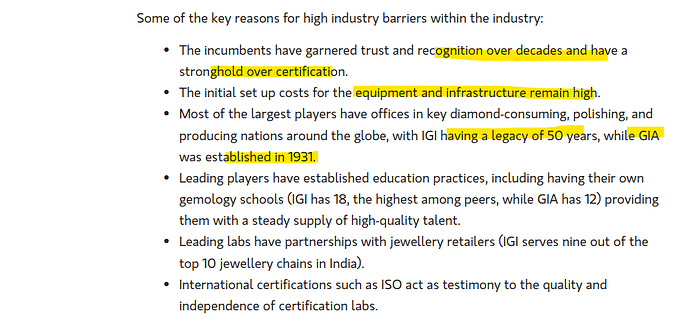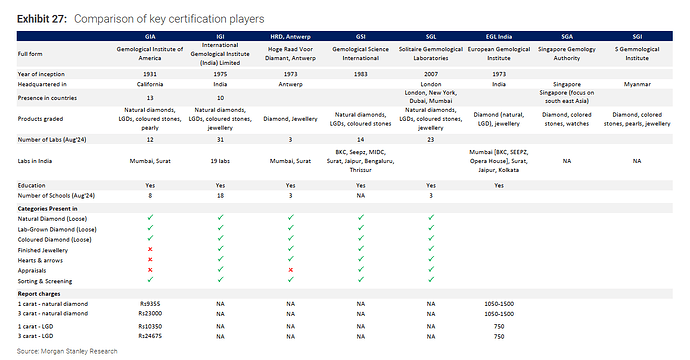In India
If you go out to buy diamonds, first thing you will ask is “Is this certified” ?
On certificate everything is clearly mentioned.
My understanding is HNI’s are not the target customers, even now most of the middle and upper middle class are aspirational and can’t afford a natural diamond, but LGD’s are more cheaper and attractive alike natural diamonds. certification, most of it takes place at the manufacturing level.
read this abstract from the MS report: Owing to the capital intensive nature of the industry and low returns now, there is a
possibility that growers are unable to reduce selling prices of rough LGDs much further.
We note that the LGD price decline has slowed to 37% from CY 2020 to CY 2023, vs the
65% decline from CY 2016 to CY 2020. There may be further price erosion in other parts
of the value chain (at the retail level, in our view), but this might not affect the
certification industry much as most of the certification takes place at the midstream level
(manufacturing level).
Here’s a summary of what the diamond price correction means for IGI, according to the MS REPORT:
- LGD prices tend to follow the prices of natural diamonds; LGD prices are unlikely to stabilize until natural diamond prices do.
- LGDs are typically priced lower than natural diamonds, but recently, the price difference has grown.
- The price correction is more noticeable at the wholesale level compared to retail.
- The increasing number of LGD producers, coupled with improved technology, has led to oversupply.
- IGI’s revenue per report has been increasing in the last few years, supported by a growing mix of LGDs and larger average carat sizes. As LGDs gain traction, higher realizations per carat are driving this growth. Jewellery certification, which typically has lower realizations, would require significant volume growth to offset this trend.
- The certification business is defensive relative to the underlying diamonds.
- LGD certification growth is driven by higher volumes, and IGI has seen significant increases in LGD volumes. The company’s presence in the factories of the top LGD growers in India gives it a competitive advantage.
- LGD certification growth is led by higher volumes given the low base and with new players participating in the LGD production.
- Even with price corrections, LGD certification continues to grow due to increased volume.
- IGI has seen a ramp up in LGD volumes, with revenue share of LGD rising to over 50%.
- The increasing LGD mix is expected to sustain the upward trajectory in average revenue per report. The certification cost for natural and lab-grown diamonds is the same, but the certification price per report of LGDs is almost half that of natural diamonds on a per carat basis.
- IGI’s strong presence in the factories of all the top 10 LGD growers in India gives it a competitive edge.
Will certification be necessary if prices continue to fall?
- LGD certification is tied to establishing credibility and trust while LGDs are building their market presence. LGDs are assessed using the same 4Cs as natural diamonds, making certification important for determining their price.
- However, if LGD demand does not remain strong, LGD certification pricing may be corrected, which could lead to lower growth rates for IGI.
- If LGDs shift towards being fast fashion items, the need for certification may decrease significantly.
What if LGD goes the fast fashion way?
- If the supply of LGDs increases while demand slows, it could lead to excess inventory, potentially pushing retailers to sell through fashion channels, which may not require certification and could lower prices.
Snippets from retailers
De Beers:
- De Beers initially ventured into LGDs with its Lightbox brand but has refocused on manufacturing LGDs for industrial use only.
- The company is re-emphasizing natural diamonds and wants to differentiate them clearly from LGDs.
- De Beers believes LGDs are shifting to low-priced fashion jewellery as their value decreases.
- In India, De Beers has partnered with Tanishq to promote natural diamonds and educate consumers.
Signet:
- Signet, the world’s largest retailer of diamond jewellery, has seen LGD jewellery pieces carrying higher margins and average transaction values than natural diamonds.
- Signet uses LGDs to expand its fashion business, traditionally having lower natural diamond penetration.
- Customers are asking for LGDs because they can get larger carat sizes for the same budget.
- Signet has collaborated with De Beers to highlight the rarity and timelessness of natural diamonds.
Titan Management:
- Titan has not seen significant customer demand for LGD products, with most purchases in the ₹50,000-₹60,000 range, and customers are less willing to buy LGDs above ₹100,000.
- Customers actively request certification for natural diamonds after the rise of LGDs.
- Titan does its certification internally.
- Titan believes the Indian market may differ from the US in LGD adoption due to cultural factors.
- LGDs have performed well in the US in center stone diamond rings but haven’t scaled in Europe, China, or the Middle East.
Goldiam Management:
- Goldiam launched its ORIGEM store for LGD jewellery in India and plans to open more stores.
- Competition in the Indian retail space for LGDs is intensifying but remains relatively small.
- Prices of LGDs under two carats have stabilized and are rising.
- Consumers are shifting to LGDs at higher price points and are buying for everyday fashion.
- LGD prices have largely stabilized as oversupply issues correct after production shutdowns.
Do the follow same procedure / equipments as IGI? This is new to me, I thought only 2 players are there and technology is difficult for certification. Does this means others can enter in business line of IGI?
strong reputation and credibility, hard to build.
It take years to built credibility in this business, if not decades.
There are other players, refer to MS report Exhibit 27 :
The top 2 have 80% market share.
What’s going on the price dropping, is this because of market conditions because I don’t see anything wrong in the company’s fundamentals.
It could be related to market conditions only because fundamentals until now seems promising & upcoming quarter results haven’t announced yet. Nothing to think otherwise.
Disc: Invested
Price dropping because the share is overvalued.
Price to Sales Ratio is more than 28…
I thought it may be because of the dividend. I, for one, was hoping for higher dividend for such high cash flow + roce company.
Could also just be ipo retailers. not sure.
disc: invested
its an interim dividend, but for some reason I think the sales this quarter should bee good as its the wedding quarter but then again the cost launching an IPO. the future of the company looks good. even if the LGD prices may drop they still will need a certification else there would not be a way to identify one category of LGD from another category of LGD. hoping for a good quarterly results.
This snapshot from Goldiam’s concall answers why certification for LGD wont be required in the future.
The certification for natural diamonds was required because of their high costs so that customers could ensure that the diamonds are real. With the costs coming down and LGD becoming more of a commodity, the need for certification would go away. Or else, even if some buyers ask for it, I think the margins for companies like IGI will come down a lot
This is what I said here, it would not matter unless it’s an appreciative asset, no one would care for certification for something that loses 80-90% of value the moment you buy it.
We can debate about the growing market size of certification industry for the lab grown diamonds, but the share still looks overvalued.
Even established Rating Agencies like Crisil do not demand such high Price to Sales Ratio of 28 times. (Crisil is around 10 times)
Still feel there is much more room for correction.
Is one bad quarter away from heavy correction in my books.
Not to mention their promoters Blackstone can offload their 100% Pledged shares anytime…
Do go through the IPO document. They have acquired two companies - one in Belgium and there was another one. The companies were acquired from the promoter Blackstone.
One of the stated use of IPO proceeds was buying out Blackstone stake from those two companies. Proforma for these acquisitions, the price to sales number will not be that high. So what you are seeing on screener is not a true representation.
I remember the two entities had substantial sales but were not very profitable. So you can maybe still rely on the P/E number from screener.
Disclosure: not invested
Terminal value risk.
1.independent certification in the first place is originated due to mistrust on retailers selling ungenuine products.
2. DiamondProof only confirms if a stone is natural or needs further testing, but need further grading like cut, clarity, carat, color, which is crucial for valuing diamonds.
3. IGI is a leader in certifying lab grown diamonds, consumers still need certification for assessing quality and value.
RUNDOWN IS INDEPENDENT THIRD PARTY VERIFICATION STILL MATTERS
In an interview during ipo time, the promoter said Blackstone would be continuing for atleast 10 years with a provision to extend. I don’t know if it was a general statement or technical in the sense agreed upon paper.
I spoke to a jeweller friend and asked him why anyone would go for certifying a lab diamond when we know it is not natural or original. He said the lab diamonds are having all features of a natural diamond so they are different from being fake stones. If you dont ask for certification, there would be no difference left between any ordinary stone and a diamond…



